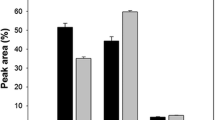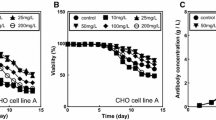Abstract
The effects of growth factors, such as insulin, transferrin, lactoferrin, ethanolamine, and selenium, on proliferation and IgM production of human-human hybridomas HB4C5 cells in a serum-free enriched RDF (eRDF) medium were studied. Among them, lactoferrin markedly stimulated proliferation and IgM production of the cells. Another iron-binding protein, transferrin, stimulated proliferation of HB4C5 cells as well as lactoferrin, but its stimulatory effect on IgM production was negligible. The proliferation and IgM production of HB4C5 cells gave some detectable delays in conventional ITES-eRDF medium at low cell densities, but the delays were avoided by the addition of lactoferrin. However, eRDF medium supplemented with lactoferrin could not support proliferation and IgM production of the cells at high cell densities. For proliferation and IgM production of HB4C5 cells, eRDF medium supplemented with 25 μg/ml lactoferrin, 10μM ethanolamine, 35 μ/ml transferrin, and 2.5 nM selenium (LETS-eRDF) gave the best result. Lactoferrin stimulated proliferation of human-human and mouse-mouse hybridomas producing IgG or IgM, but stimulation of Ig production was detected only in IgM producers. These results suggest that cell proliferation, IgM production, and IgG production of hybridomas are regulated by different mechanisms.
Similar content being viewed by others
Abbreviations
- MoAb:
-
monoclonal antibody
References
Aihara K, Yamada K, Murakami H, Nomura Y and Omura H (1988) Production of human-human hybridomas secreting monoclonal antibodies reactive to breast cancer cell lines. In Vitro Cell. Develop. Biol. 24: 959–962.
Barnes D and Sato G (1980) Serum-free cell culture: a unifying approach. Cell. 22: 649–655.
Blazar BA, Sutton LM and Strome M (1983) Self-stimulating growth factor production by B-cell lines derived from Burkitt's lymphomas and other lines transformed in vitro by Epstein-Barr virus. Cancer Res. 43: 4562–4568.
Colcher D, Hand PH, Nuti M, and Schlom J (1981) A spectram of monoclonal antibodies reactive with human mammary tumour cells. Proc. Natl. Acad. Sci. USA 78: 3199–3203.
Cuttitta F, Rosen S and Gazdar AF (1981) Monoclonal antibodies that demonstrate specificity for several types of human lung cancer. Proc. Natl. Acad. Sci. USA 78: 4591–4595.
Engvall E and Perlmann P (1971) Enzyme-linked immunosorbent assay (ELISA) quantitative assay of immunoglobulin G. Immunochemistry 8: 871–874.
Gordon J, Ley SC, Melamed MD, English LS and Hughes-Jones NC (1984) Immortalized B-lymphocytes produce B-cell growth factor. Nature 310: 145–147.
Harriman GR, Kunimoto DY, Elliott JF, Paetkau V and Strober W (1988) The role of IL-5 in IgA B cell differentiation. J. Immunol. 140: 3033–3039.
Hashizume S, Kuroda K and Murakami H (1983) Identification of lactoferrin as an essential growth factor for lymphocytic cell lines in serum-free medium. Biochim. Biophys. Acta 763: 377–382.
Hashizume S, Murakami H, Hirose S, Shirai T, Shinohara K and Omura H (1986) Human-human hybridomas from lung cancer patients secrete anti-DNA antibodies. Agric. Biol. Chem. 50: 1351–1353.
Hashizume S, Kuroda K and Murakami H (1987a) Cell culture assay of biological activity of lactoferrin and transferrin. In: Barnes D and Sirbasku DA (eds.) Methods in Enzymology, Vol. 147, pp. 302–314. Academic Press, Orlando.
Hashizume S, Murakami H, Kamei M, Hirose S, Shirai T, Yamada K and Omura H (1987b) Specificity of anti-polynucleotide monoclonal antibodies from human-human hybridomas. In Vitro Cell. Develop. Biol. 23: 53–56.
Imai K, Ng AK and Ferrone S (1981) Characterization of monoclonal antibodies to human melanoma-associated antigens. J. Natl. Cancer Inst. 66: 489–496.
Köhler G and Milstein C (1975) Continuous cultures of fused cells secreting antibody of predefined specificity. Nature 256: 495–497.
Murakami H, Masui H, Sato GH, Sueoka N, Chow TP and Kano-Sueoka T (1982) Growth of hybridoma cells in serum-free medium: ethanolamine is an essential component. Proc. Natl. Acad. Sci. USA 79: 1158–1162.
Murakami H, Hashizume S, Ohashi H, Shinohara K, Yasumoto K, Nomoto K and Omura H (1985) Human-human hybridomas secreting antibodies specific to human lung carcinoma. In Vitro Cell. Develop. Biol. 21: 593–596.
Murakami H (1987) Production of monoclonal antibodies with human-human hybridomas in serum-free culture and its prospects for medical uses. In: Umeda M et al. (ed.) Biotechnology of Mammalian Cells, pp. 119–136, Japan Sci. Soc. Press, Tokyo/Springer-Verlag, Berlin.
Murakami H and Yamada K (1988) Production of cancer specific monoclonal antibodies with human-human hybridomas and their serum-free, high density, perfusion culture. In: Spier RE and Griffiths JB (eds.) Modern Approaches to Animal Cell Technology, pp. 52–76. Butterworths, England.
Murakami H (1989) Serum-free media used for cultivation of hybridomas. In: Mizrahi A (ed.) Advance in Biotechnological Processes, Vol. 11, pp. 107–141, Alan R. Liss, Inc., New York.
Ohashi H, Hashizume S, Murakami H, Aihara K, Shinohara K and Omura H (1986) HO-323, a human B lymphoblastoid cell line useful for making human-human hybridomas. Cell Biol. Intl. Rep. 10: 77–83.
Prete G del, Maggi E, Parronchi P, Chretien I, Tiri A, Macchia D, Ricci M, Banchereau J, Vries J de and Romagnani S (1988) IL-4 is an essential factor for the IgE synthesis induced in vitro by human T cell clones and their supernatants. J. Immunol. 140: 4193–4198.
Shinmoto H, Murakami H, Dosako S, Shinohara K and Omura H (1986) Human-human hybridomas secreting IgM-like immunoglobulin with α and μ heavy chains. Agric. Biol. Chem. 50: 2217–2223.
Shinmoto H, Murakami H, Yamada K, Dosako S and Omura H (1988) Immunoglobulin production stmulating and inhibiting factors derived from human lung adenocarcinoma PC-8 cells. Cytotechnology 1: 295–300.
Snapper CM and Paul WE (1987) Interferon-γ and B cell stimulatory factor-I reciprocally regulate Ig isotype production. Science 236: 944–947.
Snapper CM, Peschel C and Paul WE (1988) IFN-γ stimulates IgG2a secretion by murine B cells stimulated with bacterial lipopolysaccharide. J. Immunol. 140: 2121–2127.
Tosato G, Gerrard TL, Goldman NG and Pike SE (1988) Stimulation of EBV-activated human B cells by monocytes and monocyte products. Role of 131–1 cell stimulatory factor 2/IL-6. J. Immunol. 140: 4329–4336.
Yamada K, Akiyoshi K, Murakami H, Sugahara T, Ikeda I, Toyoda K and Omura H (1989). Partial purification and characterization of immunoglobulin production stimulating factor derived from Namlwa cells. In Vitro Cell. Develop. Biol. 25: 243–247.
Yano T, Yasumoto K, Nagashima A, Murakami H, Hashizume S and Nomoto K (1988) Immunohistological characterization of human monoclonal antibody against lung cancer. J. Surg. Oncol. 39: 108–113.
Author information
Authors and Affiliations
Rights and permissions
About this article
Cite this article
Yamada, K., Ikeda, I., Sugahara, T. et al. Stimulation of proliferation and immunoglobulin M production by lactoferrin in human-human and mouse-mouse hybridomas cultures in serum-free conditions. Cytotechnology 3, 123–131 (1990). https://doi.org/10.1007/BF00143674
Received:
Accepted:
Issue Date:
DOI: https://doi.org/10.1007/BF00143674




